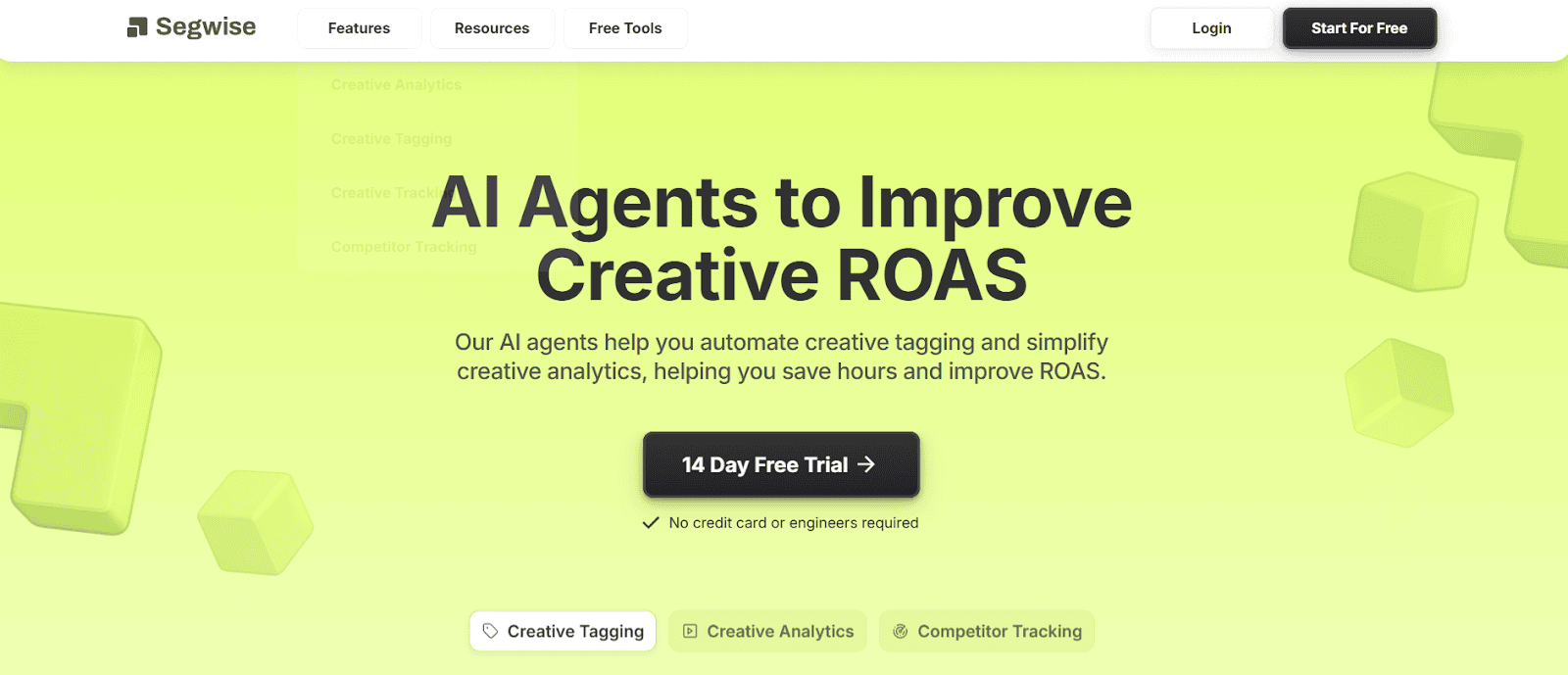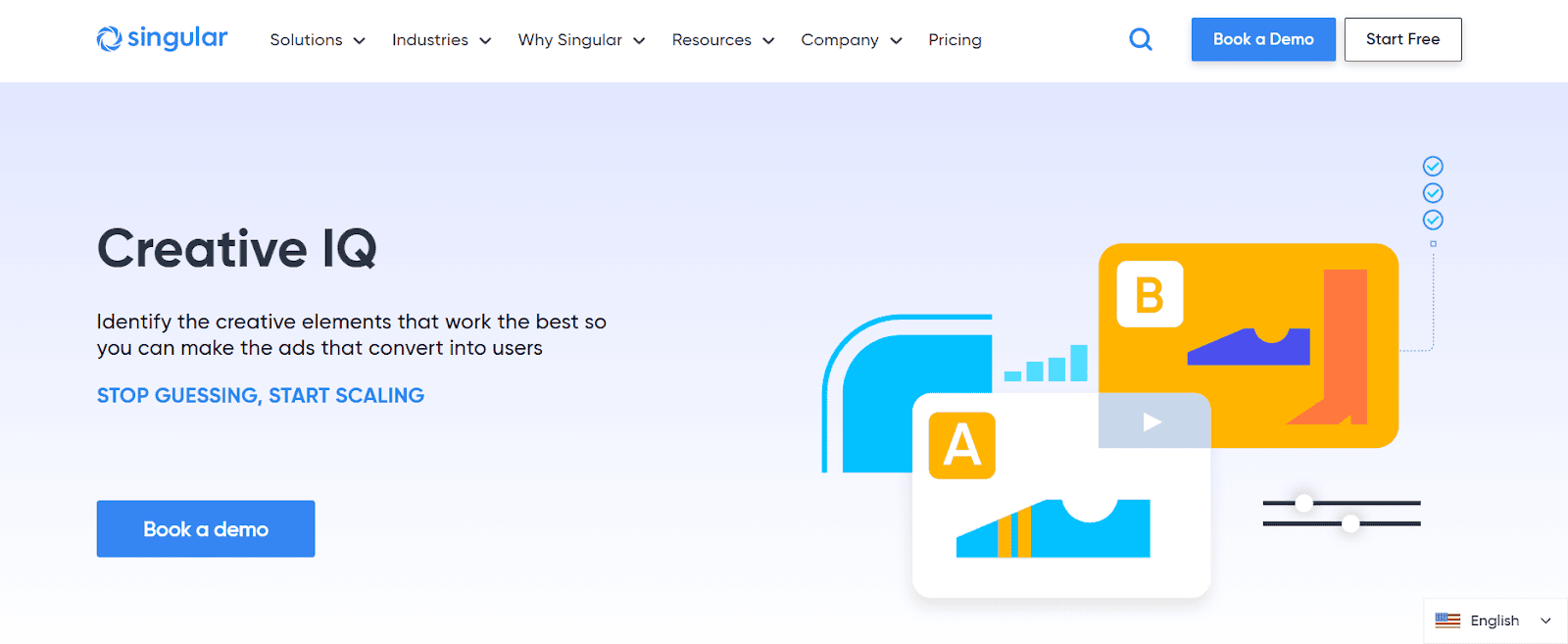Segwise vs Singular: Which Analytics Tool is Right for You?
Creative performance drives growth, but tracking it has never been more complicated. With ad platforms rolling out endless formats and variations, marketers struggle to answer a simple question: which creative actually works? Hours are spent manually tagging assets, analyzing spreadsheets, and switching between dashboards, all while ROAS targets keep climbing.
That’s where AI-powered creative analytic tools come in. By automating creative tagging, surfacing real-time insights, and showing exactly which ads drive conversions, modern solutions make it possible to scale campaigns faster and smarter.
In this post, we’ll compare Segwise and Singular; two leading tools in the creative analytics space. You’ll see how they approach automation, insights, and performance tracking differently, and which platform makes the most sense if your goal is to save hours, optimize ROAS, and scale winning creatives faster.
Key Takeaways
AI-Powered Creative Analytics: Segwise automates creative tagging and surfaces real-time insights, helping you save hours of manual work.
Attribution vs. Creative Focus: Singular excels at multi-channel attribution, but it lacks deep AI-driven creative performance tracking.
Faster ROAS Optimization: Segwise helps you identify winning creatives quickly and ties insights directly to improved ROAS.
Efficiency and Scalability: If your goal is to scale campaigns efficiently and maximize creative performance, Segwise delivers a more streamlined, automation-first experience.
Enterprise-Level Attribution Strengths: While Singular supports enterprise attribution needs, Segwise complements and enhances these workflows by adding the creative intelligence layer that most large teams now find essential for true performance optimization.
What is Segwise?

Segwise is an AI-powered creative analytics platform that helps marketers automate creative tagging and track ad performance across channels. It delivers real-time insights on which creatives drive conversions, helping you optimize ROAS and scale campaigns faster.
Segwise integrates with major ad platforms like Meta, Google, TikTok, LinkedIn, YouTube, and Snapchat. It can also integrate with MMPs and CDP and gives you control over every report to choose from either the ad network or the MMP/CDP. It makes it easy to analyze performance across channels from a single dashboard.
What is Singular?

Singular offers a feature called Creative IQ, positioned as its creative analytics layer. It helps marketers view and compare ad creatives alongside performance metrics within the same dashboard. Creative IQ automatically tags a limited set of attributes (such as format, text, and color) and connects them with high-level campaign outcomes like installs or ROAS.
While this provides a helpful overview, the tagging depth is predefined and static, typically covering around 17 standard attributes. It does not detect nuanced elements such as hooks, overlays, emotions, or dialogue patterns, the creative signals that actually drive engagement and conversions.
In essence, Singular’s Creative IQ helps visualize creative trends, but it stops short of delivering true creative intelligence. It’s ideal for reporting and comparison, not deep optimization. For teams looking to analyze performance at the element level, automate tagging, or link creative components directly to metrics like CTR, CPI, and LTV, Segwise offers far greater precision and automation.
Also Read: Creative Analytics Explained: How To Track, Measure, And Improve Ad Performance
Feature Comparison: Segwise vs Singular
Both Segwise and Singular fall under the creative analytics and marketing measurement space, but they’re designed to solve different problems. If you’re evaluating which one fits your workflow, here’s a detailed side-by-side breakdown:
Feature | Description | Segwise | Singular |
Core Focus | AI-powered creative analytics with deep element-level insights. | ✔️ | ❌ (Attribution-first) |
Creative Tagging | AI tagging for hooks, CTAs, dialogues, visuals, emotions, benefits, features, custom tags, playable tagging, and nomenclature tagging. | ✔️ | ✔️ (17 standard tags, limited depth) |
Creative Insights | Shows detailed element-level performance across visuals, CTAs, and messaging. | ✔️ | ❌ (High-level only) |
ROAS Optimisation | Maps creative elements directly to ROAS, CTR, and CPA for faster scaling. | ✔️ | ✔️ (Creative-level, not element-level) |
Multi-Channel Coverage | Works across Meta, Google, TikTok, Snapchat, plus programmatic platforms like AppLovin, Mintegral, IronSource, Unity. | ✔️ | ✔️ |
Creative Fatigue Detection | Sends alerts when creatives start underperforming for proactive asset refreshes. | ✔️ | ❌ |
Ease of Use | Plug-and-play setup with no-code onboarding and instant dashboards. | ✔️ | ❌ (Requires technical setup) |
Integrations | Connects with paid networks like Meta, Google, TikTok + programmatic ad platforms. | ✔️ | ✔️ |
Backend & MMP Data | Integrates Appsflyer, Adjust, and Branch to unify ad network + MMP performance data. | ✔️ | ✔️ (Attribution-first focus) |
Customisable Dashboards | Fully custom dashboards and white-label reporting support. | ✔️ | ❌ |
Pricing & Accessibility | Transparent pricing with a 14-day free trial to test workflows. | ✔️ | ❌ (Enterprise pricing only) |
Customer Support | Dedicated CSM for enterprises + responsive chat and email support. | ✔️ | ❌ (Standard support only) |
Which Platform is Right for You?
Choosing between Segwise and Singular depends on your team’s goals, workflow, and priority metrics. Both platforms help analyze ad performance, but focus on solving different problems.

Choose Segwise if you want:
AI-Powered Creative Analytics (Not Just Reporting):
Segwise automates element-level tagging for hooks, CTAs, dialogues, visuals, emotions, and benefits, plus supports custom and nomenclature tagging. You get complete visibility into what creative components actually drive performance across every ad format, including videos, UGC, and playables.Actionable Creative Insights Across Networks:
See which thumbnails, hooks, CTAs, and messages perform best on Meta, TikTok, Google (YouTube), Snapchat, and major programmatic networks. Segwise links creative attributes directly to results, not just impressions or spend.Direct ROAS and CPI Mapping:
Each tag connects to campaign metrics like ROAS, CTR, CPI, and LTV, enabling you to pinpoint winning combinations and scale high-impact creatives faster, without manual analysis.Automated Workflows, Alerts, and Integrations:
Segwise includes fatigue detection, new-launch tracking, cross-network reporting, and tag enrichment agents that eliminate repetitive tagging work. It also plugs directly into MMPs such as AppsFlyer, Adjust, Branch, and Singular itself, ensuring unified performance data without paying for heavy enterprise attribution packages.Transparent, Scalable Pricing:
Segwise’s pricing is straightforward and independent of attribution bundles. You can run advanced creative analytics at a fraction of Singular’s Creative IQ cost, and even start with a free pilot to validate tag accuracy and dashboard performance.Best for:
UA managers, performance marketers, and agencies that want deep creative intelligence, real-time insights, and predictable pricing.
Choose Singular if you want:
Attribution-Centric Reporting with Basic Creative Visibility:
Singular’s Creative IQ add-on visualizes creatives next to performance data but only tags around 17 standard attributes. It’s helpful for top-level reporting yet lacks the depth needed for true creative optimization.Bundled with Attribution-Level Pricing:
Creative IQ isn’t offered as a standalone feature, you must purchase Singular’s full attribution suite, which significantly increases cost and setup complexity. For MMPs and large enterprises, this may make sense; for agile UA or growth teams, it’s usually overkill.Cross-Channel Spend Aggregation:
Singular excels at consolidating ad spend and ROI metrics across networks but focuses on where conversions happen, not why specific creatives perform.Enterprise Data Modeling:
Its advanced pipelines and customizable attribution frameworks are powerful but require technical integration and data-engineering resources. Creative teams rarely need this level of infrastructure just to analyze ads.High-Level Creative Insights Only:
Creative IQ provides macro-level trends (e.g., which format or platform performs better) but doesn’t reveal which specific elements (like copy tone, emotion, or visual cue) drive engagement.Best for:
Enterprises prioritizing attribution accuracy and finance-grade reporting over granular creative optimization.
Also Read: Top Creative Optimization Tools You Need in 2025
Conclusion
Both Segwise and Singular help marketing teams improve campaign performance, but they solve different problems. If your focus is cross-channel attribution and consolidating ad spend, Singular offers more advanced reporting for enterprise-level workflows.
But If your priority is understanding which creatives drive conversions, Segwise’s AI-powered analytics and automated creative tagging make it easier to spot winning ads, optimize ROAS, and scale campaigns faster.
For performance marketers and creative teams looking to save time, streamline workflows, and want deeper creative insights, Segwise provides a faster, automation-first solution. Start your free trial at segwise.ai
FAQs
1. How can I verify that a creative analysis tool provides reliable labels for my ads?
Conduct quick spot checks: have a small team manually label a sample set, compare those results to the tool’s output, and run A/B tests to determine if the tool’s recommendations actually increase conversion or revenue.
2. Will these tools still function after privacy changes, such as app tracking limits or the adoption of cookieless browsers?
Many tools use aggregated or server-side signals and can connect to measurement partners, but ask a vendor how they handle the specific privacy framework your apps and ad platforms use.
3. Which people in my company should be involved when we trial a creative analytics product?
Include a creative lead, a performance marketer, a data analyst, and someone from ops or legal so you cover creative use, measurement, data access, and compliance.
4. How do I turn creative insights into actual ad tests and briefs?
Translate the tool’s top-performing patterns into one-sentence hypotheses (what to change and why), then build small tests with clear success metrics and a timeline for evaluation.
5. What should I check about asset rights and content types before uploading creative libraries?
Confirm licensing and usage rights, version control for edits, and whether the vendor can tag or store metadata for user-generated content and third-party assets.

Comments
Your comment has been submitted successfully!